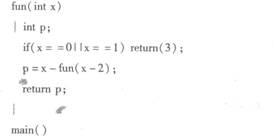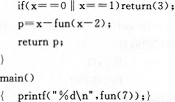下面的程序段执行后,输出的结果是以下哪个选项( )。StringBuffer buf=new StringBuffer("Beijing2008");buf.insert(7,"@");System.out.println(buf.toString());A、Beijing@2008B、@Beijing2008C、Beijing2008@D、Beijing#2008
题目
A、Beijing@2008
B、@Beijing2008
C、Beijing2008@
D、Beijing#2008
相似考题
参考答案和解析
更多“下面的程序段执行后,输出的结果是以下哪个选项( )。StringBuffer buf=new StringBuffer("Beijing2008");buf.insert(7,"@");System.out.println(buf.toString()); A、Beijing@2008B、@Beijing2008C、Beijing2008@D、Beijing#2008”相关问题
-
第1题:
有下列程序段 public class fun { public static void main(String args[]) { char b[]="Hello,you"; b[5] = 0; System.out.println(s); } 执行此程序后,得到的输出结果是( )。
A.Hello, you
B.Hello0you
C.Hello
D.0
正确答案:C
解析:本题常见的错误答案是:字符数组b初始化后,得b[5]=',',执行b[5]=0后,用0代替b[5]中的','即可。最后输出整个字符串:Hello0you。下面是正确解答:在C++语言中规定以字符'\0'作为字符串结束标志,语句b[5]=0就相当于语句b[5]='\0',即在数组b的b[5]上加了字符串结束标志,故执行该语句后,数组中存放的内容变为Hello。 -
第2题:
有以下程序:

执行后输出结果是 ( )。
A.7
B.6
C.8
D.无确定值
正确答案:A
本题考察对二维数组的使用。只要按照要求细心分析各个数组元素的位置,即可以正确的得到答案为A。 -
第3题:
有以下程序:

 执行后的输出结果是( )。
执行后的输出结果是( )。A.7
B.3
C.2 0)O
正确答案:C
-
第4题:
执行下面的程序段,输出结果为______。
publicclassQ
{
publicstaticvoidmain(Stringargv[])
{
intanar[]=newint[5];
System.out.println(anar[0]);
}
}
正确答案:×
0 解析: 本题考查Java中数组的定义和初始化。在该方法里定义并动态初始化了一个整型数组anar,由于没有赋初值,系统给默认的初始值是数组中的每个元素全部为零。所以输出数组中的第一个元素anar[O]时,自然也是等于零。 -
第5题:
设StringBuffer s=new StringBuffer("Sunday"),那么s.capacity( )的值为6
正确答案:错误 -
第6题:
public class TestString3 { public static void main(String[] args) { // insert code here System.out.println(s); } } Which two code fragments, inserted independently at line 3, generate the output 4247?()
- A、 String s = “123456789”; s = (s-”123”).replace(1,3,”24”) - “89”;
- B、 StringBuffer s = new StringBuffer(”123456789”); s.delete(0,3).replace( 1,3, “24”).delete(4,6);
- C、 StringBuffer s = new StringBuffer(”123456789”); s.substring(3,6).delete( 1 ,3).insert(1, “24”);
- D、 StringBuilder s = new StringBuilder(”123456789”); s.substring(3,6).delete( 1 ,2).insert( 1, “24”);
- E、 StringBuilder s = new StringBuilder(”123456789”); s.delete(0,3).delete( 1 ,3).delete(2,5).insert( 1, “24”);
正确答案:B,E -
第7题:
Public class test ( Public static void stringReplace (String text) ( Text = text.replace („j„ , „i„); ) public static void bufferReplace (StringBuffer text) ( text = text.append (“C”) ) public static void main (String args ){ String textString = new String (“java”); StringBuffer text BufferString = new StringBuffer (“java”); stringReplace (textString); BufferReplace (textBuffer); System.out.printIn (textString + textBuffer); } ) What is the output?()
正确答案:javajavaC -
第8题:
定义有StringBuffer s1=new StringBuffer(10);s1.append(“1234”)则s1.length()和s1.capacity()分别是多少?
- A、4;10
- B、4;4
- C、10;10
- D、10;4
正确答案:A -
第9题:
Public class test ( Public static void stringReplace (String text) ( Text = text.replace (‘j’ , ‘i’); ) public static void bufferReplace (StringBuffer text) ( text = text.append (“C”) ) public static void main (String args[]} ( String textString = new String (“java”); StringBuffer text BufferString = new StringBuffer (“java”); stringReplace (textString); bufferReplace (textBuffer); System.out.printLn (textString + textBuffer); ) ) What is the output?()
正确答案:javajavaC -
第10题:
单选题Given this method in a class: public String toString() { StringBuffer buffer = new StringBuffer(); buffer.append(‟‟); return buffer.toString(); } Which is true?()AThis code is NOT thread-safe.
BThe programmer can replace StringBuffer with StringBuilder with no other changes.
CThis code will perform well and converting the code to use StringBuilder will not enhance the performance.
DThis code will perform poorly. For better performance, the code should be rewritten: return “<“+ this.name + “>”;
正确答案: B解析: 暂无解析 -
第11题:
填空题Public class test ( Public static void stringReplace (String text) ( Text = text.replace (‘j’ , ‘i’); ) public static void bufferReplace (StringBuffer text) ( text = text.append (“C”) ) public static void main (String args[]} ( String textString = new String (“java”); StringBuffer text BufferString = new StringBuffer (“java”); stringReplace (textString); BufferReplace (textBuffer); System.out.printLn (textString + textBuffer); ) ) What is the output?()正确答案: JAVAJAVA解析: 暂无解析 -
第12题:
判断题设StringBuffer s=new StringBuffer("Sunday"),那么s.capacity( )的值为6A对
B错
正确答案: 错解析: 暂无解析 -
第13题:
执行下列程序后,输出结果为( )。 public class Test { public static void main (String[] args) { StringBuffer sb = new StringBuffer("北京 2008" ); System. out. println ("length =" + sb. length ( ) ); } }
A.length = 8
B.length = 10
C.length = 6
D.length = 20
正确答案:C
解析:StringBuffer类的length()函数是求出字符序列的长度。 -
第14题:
有以下程序:


程序执行后的输出结果是( )。
A.7
B.3
C.2
D.0
正确答案:C
在函数fun(intx)中,有个if语句判断,如果参数x等于0或1时,返回值,否则进入下面的p=x-fun(x2)递归函数。当在主函数中调用fun(7)时,其过程为:“fun(7)=7-fun(5)=7-(5-fun(3))=7-(5-(3-fun(1)))=7-(5-(3-3))=7-5=2”,所以最后的输出结果为2。 -
第15题:
设已执行预编译命令include,以下程序段的输出结果是()。char s[]="an apple";printf(" 设已执行预编译命令#include<string.h>,以下程序段的输出结果是( )。 char s[]=" an apple" ; printf(" %d\n" ,strlen(s));
A.7
B.8
C.9
D.10
正确答案:B
解析:如果一个字符数组中存放一个字符串,则函数strlen的值为“\0”之前的全部字符个数,也包括空格在内。注意:字符串处理函数的使用。 -
第16题:
下面是一段javabean程序,该程序的运行结果是( )。public class NullTest{public static void main(String[]?args){int M=0;String str=null;StringBuffer sb=new StringBuffer("=");sb.append(str);sb.append(M++);System.out.println(sb.toString( ));}}A.=null
B.=null0
C.=null1
D.=nullM答案:B解析:本题考查学生对javabean程序的熟悉程度,尤其是数值类型数据和字符串类型数据的掌握情况。M是整型变量,其值为0,str是字符串,sb是字符串空间,其中存放字符“=”,append是字符串添加函数,M++为自增运算符,它的特点是先取M的值作为表达式的值,再进行自增运算。程序的运算过程是:先将null拼接到“=”的后面,得字符串“=null”,再将0作为字符拼接到“=null”的后面,得“=null0”,M自增为1,输出结果为:=null0。 -
第17题:
字符串的append函数可以添加多种内容,以下append函数的使用中,错误的是() StringBuffer strb1 = new StringBuffer(); Integer intObj = new Integer(33);
- A、strb1.append(3.14159);
- B、strb1.append(’数’);
- C、strb1.append(true);
- D、strb1.append(intObj);
正确答案:D -
第18题:
String与StringBuffer的区别()。
- A、String是不可变的对象,StringBuffer是可以再编辑的
- B、String是常量,StringBuffer是变量
- C、String是可变的对象,StringBuffer是不可以再编辑的
- D、以上说法都不正确
正确答案:A,B -
第19题:
关于String和StringBuffer,下面那些是正确的:()
- A、常量字符串使用String,非常量字符串使用StringBuffer。
- B、使用StringBuffer的时候设置初始容量。
- C、尽量使用StringTokenizer代替indexOf()和substring()。
- D、尽量不要使用StringBuffer,StringTokenizer类。
正确答案:A,B,C -
第20题:
Given this method in a class: public String toString() { StringBuffer buffer = new StringBuffer(); buffer.append(‟<‟); buffer.append(this.name); buffer.append(‟>‟); return buffer.toString(); } Which is true?()
- A、 This code is NOT thread-safe.
- B、 The programmer can replace StringBuffer with StringBuilder with no other changes.
- C、 This code will perform well and converting the code to use StringBuilder will not enhance the performance.
- D、 This code will perform poorly. For better performance, the code should be rewritten: return “<“+ this.name + “>”;
正确答案:B -
第21题:
以下语句的含义是() char[] arrcrlf={13,10}; String crlf=new String(arrcrlf); stringBuffer dest = new StringBuffer("西行漫记"); dest.append(crlf);
- A、字符串"西行漫记"不变
- B、字符串"西行漫记"的最后一个字被删除
- C、语句存在语法错误
- D、在字符串"西行漫记"的后面加回车换行符
正确答案:D -
第22题:
单选题有以下程序段:程序执行后的输出结果是( )。A15
B100
C150
D10
正确答案: B解析:
定义宏函数MAX返回x和y中的较大值。因此语句“MAX(i,j)”的值为15,执行“k=MAX(i,j)*10;”,输出k的值为150。 -
第23题:
填空题Public class test ( Public static void stringReplace (String text) ( Text = text.replace („j„ , „i„); ) public static void bufferReplace (StringBuffer text) ( text = text.append (“C”) ) public static void main (String args ){ String textString = new String (“java”); StringBuffer text BufferString = new StringBuffer (“java”); stringReplace (textString); BufferReplace (textBuffer); System.out.printIn (textString + textBuffer); } ) What is the output?()正确答案: javajavaC解析: 暂无解析
